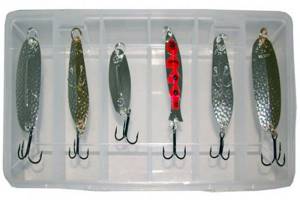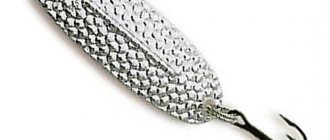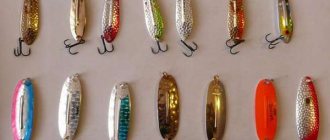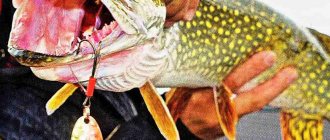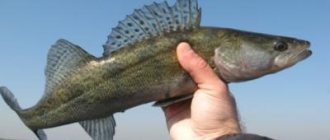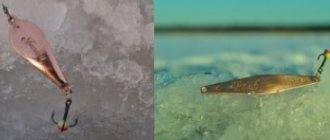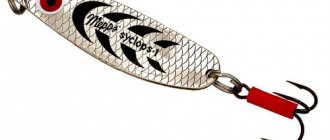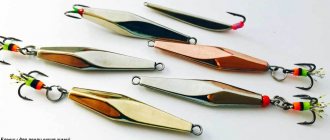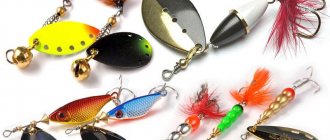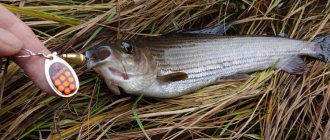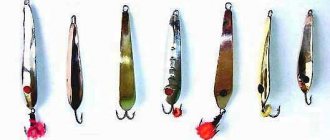The famous Canadian manufacturer of spinners, the Williams company, has a hundred-year history, and during this time it has gained great trust from consumers around the world. The company was founded back in 1916, and almost from the very beginning it produced very high-quality products made from expensive materials. The coating of some spinners is made of silver and gold, so counterfeiting of such products is practically impossible.
A brief history of the creation of the Williams spinner
The Williams brothers, the founders of the company, were developing gold deposits and saw the heyday of the gold rush. They had a practical approach to business, and they sought to use the mined gold as a material. So, in 1897, the brothers created their first company, which produced gold teeth. Both of them were active fishermen, and over time they focused their attention on the production of spinners. Experiments with coating spinners with silver and gold gave excellent results, and the famous company was founded in 1916. In the same year, their signature product, the Wabler spinner, was released.
Features of the production of Williams spinners
The main material for Williams spinners is high-grade brass. This material was not chosen by chance, and it has a number of advantages compared not only to iron, but also to stainless steel. Brass does not rust, sounds great in water, it is strong and flexible, quite easy to process, and at the same time can be combined with other metals, at least with the same precious ones. Production takes place using this technology - a roll of brass passes through an automatic press matrix, which can make thousands of blanks at once. The plant's capacity allows for the production of 6,000 spinners per hour. A characteristic feature of all these baits is a longitudinal groove, which makes them more stable in the water. In some ways, such a gutter is similar in functionality to a ship’s keel. The complete manufacturing process of spinners goes through as many as 24 stages, starting from the moment of cutting out the brass blank. Initially, they are mounted in frames that allow hundreds of spinners to be dipped into the cleaning solution at once in order to completely remove any possible dirt or deposits from them. Next, there is a sequential immersion in vats of various acids, where an important galvanic process takes place. Brass is coated externally with a thin layer of copper and then coated again with nickel.
Williams spinners are coated with gold and silver
Even at this stage, Williams spinners have much better characteristics than cheap Chinese consumer goods. But work with them is just beginning - the already nickel-plated surface is perfectly cleaned, and then a gold or silver coating (20 carats of precious metal) is applied to it. This greatly enhances the fishing qualities of the bait. For example, Williams spinners are known all over the world for their unique light play. Even at a depth of 4-5 meters, the fish will see such a spoon and bite on it. And the precious metal does not fade over time. Those spoons that were produced a hundred years ago still look bright, like a real jewel. For this reason, Williams products are very expensive, but those who can afford such a purchase will never be disappointed in it. All the company's products are elite, characterized by a service life of many decades and excellent quality.
Popular catch-catching models of Williams spinners for pike and perch
Williams brand spinners perform well in any fishing conditions - both summer and winter, in different bodies of water. These are truly universal baits, and they are guaranteed to attract the attention of a wide variety of predatory fish. Here is just a short list of fish species that simply cannot swim past such bait - trout, salmon, pike, pike perch, bass, perch, brown trout, etc. These spoons guarantee a catch in any conditions, as long as they are delivered within the fish’s field of view.
The legendary Williams Wabler has already celebrated its centenary. Today it is produced in almost the same form as in 1916. This is one of the most sought-after baits in the entire company's range, with unique performance characteristics, whose advantages have been confirmed by many thousands of wealthy fishermen around the world over generations of use. Its versatility is especially good for all-season use - it is equally suitable for fishing in any weather and at any time. The working depth range of the Williams Wobbler spinner is from shallow water to 6 meters. Micro-oscillators are also very popular in the company’s product range. They are available in different sizes - from 25 to 38 mm. They will work well for small fish, such as perch or bleak, but for larger trout or ide you will need sizes up to 67 mm. In the Williams product range there are even larger spinners, 102 mm. They have already caught very large, trophy fish - catfish, large pike, salmon.
Effective retrieves of the Williams Wobbler spinner
Experienced fishermen recommend alternating types of retrieves (this is universal advice that is suitable for any fish and any bait), using either the classic stepped or stop-n-go, with frequent descents to the very bottom. In this case, Wobbler spinners behave very well with free gliding; fish very often bite on them at this time.
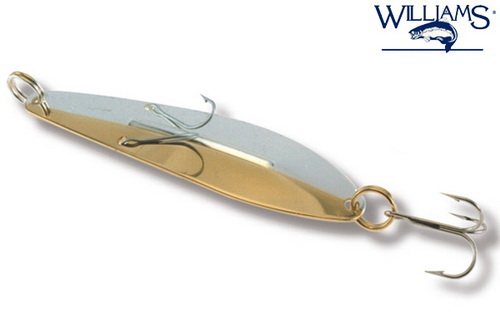
Another very successful model is the Williams Ice Jig - this is really a jig for fishing under ice. It is used in different ways, both for casting and for vertical plumb. This bait has a very well defined characteristic groove, which gives it not only stable play, but also gliding with a slight wobble, which the fish really like. Williams Ice Jig has three hooks at once - two additional ones in the very center, which is quite unusual for spinners. Additional hooks give good results.
The Williams Ice Jig is quite narrow, so it can quickly sink to the very bottom of the reservoir. Its shape and weight are carefully balanced, so the inertia of the water flow cannot bring the spoon to the surface. Even in bodies of water with strong currents, it will behave as it should. If there is no particular current, then jig wiring will work well for this bait. The Williams Ice Jig model is used for catching pike perch, pike, trout, and other large fish.
The Williams Dartee model is very original in shape and characteristics. It has a very high concavity, an unusual bend. The company began producing this bait in 1990. The unusual shape allows the spoon to make a kind of “yaw” movement, which attracts fish even from afar. Also, this spoon has a very well balanced weight, which allows it to quickly and confidently go deeper in the water.
Optimal wiring of the Williams Dartee spinner
Slow retrieves and medium-depth ponds are recommended for this bait. This model also well reveals the potential of spinners, which is obtained at the time of galvanization, even at the manufacturing stage.
The moment Williams Darty touches the water, they create a so-called galvanic couple and emit electromagnetic waves. This has an extremely positive effect on the fish’s sensory organs, so predators immediately begin to look for the source of the “signal”. Of course, plastic or silicone baits cannot boast of anything like this. If you constantly pause while retrieving, the spoon of this model will show an excellent catch. It is very effective in both winter and summer, and is clearly visible to fish even at night. Chub, asp, ide, etc. are usually caught using a Williams Darty lure.
The Williams Quick Silver spinner is one of the smallest in weight in the company’s range. At the same time, it is perfectly balanced, has a well-thought-out geometry, and is best suited for slow retrieves with long pauses. This model is best used in the hot season, for well-fed and passive fish. For example, it is great for catching pike, even if the predator is completely lazy and doesn’t bite anything else. The Williams Quick Silver spinner is also interesting because it can be hooked in different ways - both from the front and from the back, simply by changing the position of the hook.
This allows, under other identical conditions, to always get two different games in the water column. And in the Williams Quick Silver model, a hologram is applied to the precious coating, which further interests the fish. The Williams Quick Silver bait is available in a large number of colors. Williams spinners are a world-famous brand, a symbol of quality, deservedly considered the best of their kind. Not every fisherman will be able to afford a spoon coated with gold, or at least silver, but the regular large catch from its presence will more than justify the initial monetary cost of the bait.
The QUICK SILVER spinner of the WILLIAMS brand is distinguished by a unique action that imitates the movements of a wounded fish. Works great for catching large lake trout, salmon, as well as pike perch and pike.
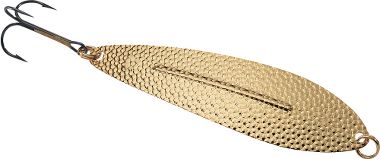
Today we’ll talk about oscillating spoons. One fine summer morning, I received a call from a friend of mine who was on a trip in another city. He said that he would like to bring me a gift from another city and asked what exactly I wanted that we didn’t have. In response, I didn’t think long and answered that I wanted an oscillating spoon weighing approximately 20 grams. For the conditions of my fishing at that time, it was ideal and I had my favorite in this weight. After a short dialogue, I went back to sleep.
I didn’t attach much importance to the conversation, but still I was worried about curiosity, what exactly would he bring? And so the next day my friend is already standing on the threshold and with a satisfied smile hands me a spinner. It was a Williams WhiteFish C70 spinner. “How big she is,” flashed through my head, and I smiled in response. In general, everyone was happy, and after a couple of hours I began to get to know the spoon better.
Williams WhiteFish is great for pike
Of course, before this event, I heard about Canadian spinners from Williams, about silver and gold coating, a special rib on the body of the spinner and much more. And now I was holding such a spinner in my hands. The Williams WhiteFish C70 is almost 11 cm long and weighs 21 grams.
Compared to its classmates in terms of weight, this spoon looks simply huge. And the whole point is in the very concept of this spinner. She belongs to the class of planners. The large body area with a relatively low weight allows it to glide during pauses in the retrieve. The spoon does not fall like a stone to the bottom, but sways smoothly in the water column like a fallen autumn leaf. This additionally encourages the predator to bite.
Now let's talk about the rib on the body of the bait. Such an edge passing through the body of the bait is a feature of Canadian Williams spinners. It is designed to prevent the spinner from spinning at high fishing speeds. Of course, this feature makes its contribution to the game of the bait, but if you try very hard and turn the reel handle quickly, you can still spin the bait into a corkscrew.
The Williams WhiteFish C70 spinner in my color has a gold finish. The manufacturer and advertising slogans in every possible way assure that the bright shine of natural silver and gold attracts fish as well as anything else. I can confirm that the lure in such a coating looks simply beautiful and does not fade, but I cannot say how important the gold standard on your lure is to a predator. The surface of my spoon is smooth, but there are models with a so-called “broken” coating. What should be shown better by comparative practice.
At the top of the spoon (the upper part is wider) there is an inscription in English “Williams 70”, and at the bottom of the spoon - “made in Canada”. The winding rings are of very high quality, the same color as the spinner, the tee is also good, but over time it may need to be replaced.
Two options for fishing with Williams WhiteFish spinners
The peculiarity of this spinner is that when you buy one spinner, you, in a sense, get two. We are all accustomed to the layout of oscillating spinners, when the front part is narrower and the rear part is wider. The Williams WhiteFish C70 spinner is an exception to this rule; here it’s the other way around. But nothing prevents you from removing the tee from the winding ring of the narrow part and putting it on the winding ring of the wide part. And now we have in our hands a classic oscillating spoon, but with a gold coating, a stiffening rib and other advantages that this bait has. Frankly, in all the time that I have owned this bait, I personally have never rearranged the tee according to the classical scheme. But I will make up for lost time!
Due to its large area and low weight, the spoon has a short casting range, and its dimensions imply its use at depth when catching large bottom pike. Therefore, it is most convenient to fish with this lure from a boat. It wouldn't hurt to have a small echo sounder on your small boat. It is the use of an echo sounder that will help you find ideal conditions for using this spoon.
Changes in depth, underwater edge steps, snags, piles of stones. It is the placement of the spinner in such places with long pauses that provokes a large passive predator to attack. The Williams WhiteFish C70 spinner is one of those that needs to be cast as slowly as possible. The game turns out to be smooth and sweeping; during pauses, the spinner swings smoothly and slowly sinks. It’s a good idea to lead this lure by letting it fall to the bottom, and then jerking it with the tip of the rod or a sharp turn of the reel. Just like a jig bait.
But I don’t have the nerves to wire this spinner like that - it’s too expensive. By the way, when you go fishing with such a lure, remember that the hook is your best friend. It’s better to spend money on unhooking once than to then unwind a helplessly sagging cord with trembling hands. Any cut costs several times less than a Williams spinner. I went through this, so I know what I’m talking about, although of course the hook often seems like an absolutely unnecessary and superfluous thing in a crowded fishing suitcase with baits. But this feeling disappears so quickly when you spin the boat around a tight line leading to an expensive hooked bait.
Features of wiring Williams WhiteFish spinners
This is how I most often got my pikes on this lure - with a slow step-by-step retrieve above the very bottom. It also worked on trolling. When moving from place to place, I, of course, throw some kind of wobbler behind the stern of the boat. Well, I also used a Williams WhiteFish spinner a couple of times. In Canada, trolling with large oscillating spoons is much more popular than here. But it’s true that at low speeds on the oars or at minimum engine speeds, this spinner actually works in the best fishing conditions for it. Therefore, when moving from place to place or just going trolling, do not forget to put a Williams WhiteFish on a leash as an experiment.
But lately I’ve been fishing with Williams WhiteFish less and less. And it’s not about the lure, I just have a different boat and different fishing conditions now. Now I fish almost all the time in shallow water. But it’s difficult to use this bait in my size, because the size of the expected trophies is not the same. In general, this option in my current conditions is not optimal. But more and more often the thought comes to buy this spoon in a much smaller size. 5-7 centimeters would be just right now. Of course, the price is stopping me, but what can I do... Apparently I'll have to spend money on my favorite thing.
The fact that every Williams spinner is necessarily coated with precious metal is amazing. Precious coating allows the lure not to fade for a long time, completely resist corrosion and uniquely shimmer in the sun. It is impossible to perfectly fake such a spinner. But it’s easy to run into a crude fake.
It’s very easy to protect yourself from fake Williams spinners! Firstly, you should not buy them from dubious places at a suspiciously low price. Secondly, if you carefully examine the original Williams Wabler spinner, you will find a miniature engraving on it “made in Canada.” There is no such inscription on fakes!
Types of Williams spinners

The company's products are classified as seasonal, and each model implies use at a certain time of the year. The differences may be that, for example, a bait for summer fishing shows excellent performance when moving horizontally, and a winter bait, respectively, when moving vertically.
Unfortunately, the range and color range of products for summer predator hunting are much more diverse than winter options, and are metal strips that can rotate around their axis, which, when moving, create vibrations similar in nature to swimming fish.
Conventionally, they are divided into two types of baits:
- Rotating.
- Oscillatory.
They received such names due to the nature of the generation of sound waves during movement. The former attract the predator due to the rotation of the working part of the bait, the latter due to the tail part of a specific shape.
Spinner for pike perch

For high-quality work, the spoon must be small in size and moderately wide to ensure that it attracts the attention of the fish. The coloring imitates the natural color of perch fish. In winter, special techniques are used: vertical wiring or specialized balancers.
Prices
- Heavy Weight Whitefish: a versatile all-season lure for walleyes. Manufacturing material: brass. Silver or gold plating depending on color. The price is at least 500 rubles.
- ICE JIG : Great for catching walleye, trout and more. It belongs to the category of all-season models, thus showing excellent results regardless of weather conditions. Has a universal color. Cost from 400 rubles.
- WILLIAMS Wabler W30OB spinner: a classic spinner that marked the beginning of the brand's history and still shows excellent results in practice. The presented model has a wide range of colors. Price from 300 rubles depending on color.
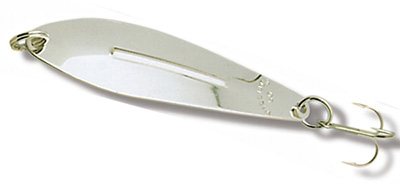
- WILLIAMS Whitefish Heavy Weight spinner: main purpose for winter types of fishing using appropriate gear. Showed excellent results on perch, pike perch and trout. Cost from 400 rubles in the classic version and higher depending on the color.
Canadian trout spoon

The choice of color depends on the body of water in which the fishing will take place. As a rule, trout fish live in two types of aquatic environments:
- Rivers.
- Specialized rates of artificial origin.
During production, the peculiarities of fishing for this specific type of fish were taken into account, and this was reflected in the weight of the bait and its shape.
Williams lure for pike
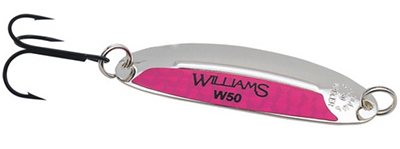
Unfortunately, oscillating models do not show such effective performance for fishing for this representative of the aquatic world. The ideal option when hunting in the warm season would be to use a light jig with long intervals between retrieving the spoon and pauses during which the bait dives to the bottom.
When fishing in the autumn-spring period, you should make a more active retrieve of the bait and be sure to allow the tackle to lie on the bottom, which can be easily determined by the sag of the fishing line.
An important point when fishing for pike is that after casting, be sure to tighten the line, since this type of fish has the peculiarity of catching bait when diving immediately after the bait hits the water.
Chinese copies and fakes of Williams spinners
Native Williams is not cheap and is more suitable for athletes when victory in competitions and valuable prizes are at stake. And for ordinary fishermen (like you and me), cheaper analogues from Rosy Dawn or German are also suitable. Moreover, they catch almost like the originals and are even cheaper than fakes.
I have repeatedly expressed my point of view regarding good analogues (not fakes) and I am still not very interested in the copyrights of Canadian Williams (they will not become poorer), and I am very glad that with the advent of clone makers, domestic fishermen have a chance to “join to the beautiful” for a reasonable price. However, we must know what we are paying for.
Counterfeits of Williams Wabler spinners, which I personally saw in our stores:
a copy from the Chinese RosyDawn, a copy of Williams Wabler from the German company, copies of Williams Wabler from Grows Culture, as well as outright fakes of Wabler, which they sold to me for 250 rubles in a fishing store.
Taking a closer look at the original Williams spinner, we will see a barely noticeable engraving with the embossed inscription “made in Canada” written around the circumference.
However, not all fakes are as bad as it might seem, and the coating will clearly not be gold, but spinners copied from Williams spinners usually work and catch fish, since the shape of the spinners is very successful.
Williams spinner - is it really perfect?!
Probably all fishermen have used a spoon at least once to catch predatory fish in winter. There is a wide range of baits of this type. They are different in their purpose, type and effect. The fisherman needs to know which of them and when is best to use to get the maximum catch.
Canadian is a famous fishing brand, known to everyone who respects the fishing of predatory fish. Williams spinners are the standard bait. Coating brass spinners with noble metals allows you to achieve stunning success.
Such baits have high catchability due to their specific coating, as well as powerful vibrations of low frequency. Ultrasonic waves will not leave even the laziest individual indifferent.
Making baits is a complex galvanic process by which a layer of gold or silver is applied to the workpiece. Next, the product undergoes a particularly thorough cleaning of the outer layer, due to which its surface becomes extremely resistant to the negative effects of the aquatic environment and does not lose its original appearance and shine over time. The use of noble metals makes it possible to obtain:
- the product is resistant to oxidation, which destroys ordinary metals;
- high reflectivity, attracting predatory fish even in muddy water;
- good adhesion of precious metal to brass due to the use of galvanic process;
The use of precious metals eliminates the possibility of counterfeiting. The products cover all known predatory fish. Their gear is distinguished by high wear resistance, long service life, and over time they do not lose their properties.
Article on topic: Silicone baits for trout
